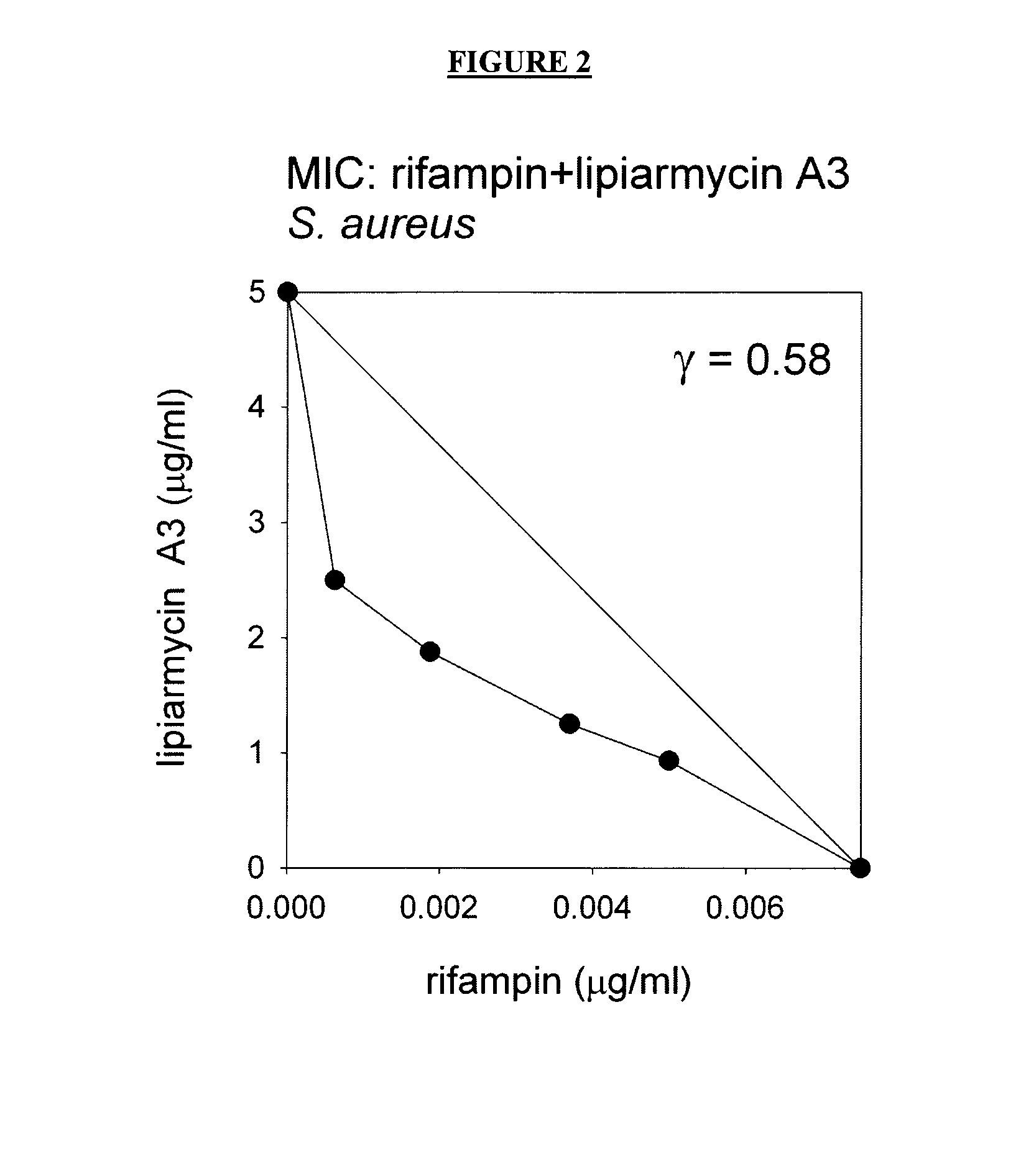Antibacterial agents: combination of a rifamycin and a switch region inhibitor
a switch region inhibitor and antibacterial agent technology, applied in the field of combination of rifamycin and switch region inhibitors, can solve the problems of grave and growing threat to public health infection, limited clinical utility of rifamycin, so as to reduce the minimum effective dose and reduce the frequency of spontaneous resistan
- Summary
- Abstract
- Description
- Claims
- Application Information
AI Technical Summary
Benefits of technology
Problems solved by technology
Method used
Image
Examples
example 1
Co-Administration of Rifampin and the Switch-Region Inhibitor Myxopyronin B Results in Synergistic Antibacterial Activity
[0111]Compound-compound interactions were assessed in “checkerboard”-format broth-microdilution antibacterial susceptibility assays essentially as described [Berenbaum, M. (1978) A method for testing for synergy with any number of agents. J. Infect. Dis. 137, 122-130; Norden, C., Wentzel, H. & Keleti, E. (1979) Comparison of techniques for measurement of in vitro antibiotic synergism. J. Infect. Dis. 140, 629-633]. Assays were performed using Staphylococcus aureus ATCC 12600 (5×105 cfu / well) as the assay organism and Mueller-Hinton Broth II, Cation Adjusted (100 μl / well), as the assay medium, and 14 h at 37° C. as the assay incubation time.
[0112]Isobolograms were plotted and interpreted as described [Berenbaum, M. (1978) A method for testing for synergy with any number of agents. J. Infect. Dis. 137, 122-130; Norden, C., Wentzel, H. & Keleti, E. (1979) Comparison ...
example 2
Co-Administration of Rifampin and the Switch-Region Inhibitor Myxopyronin B Reduces Spontaneous Resistance to Undetectable Levels
[0115]Spontaneous resistance frequencies in Staphylococcus aureus were determined by plating defined numbers of cells of Staphylococcus aureus ATCC12600 (1×108-1×1012 cfu / plate) on Mueller-Hinton agar containing rifampin, myxopyronin B, or both, and counting numbers of colonies after 14 h at 37° C. Experiments were performed using (a) rifampin at 1×, 2×, or 4× the minimum inhibitory concentration of rifampin administered individually; (b) myxopyronin B at lx, 2×, or 4× the minimum inhibitory concentration of myxopyronin B administered individually; or (c) both rifampin at 1×, 2×, or 4× the minimum inhibitory concentration of rifampin administered individually and myxopyronin B at 1×, 2×, or 4× the minimum inhibitory concentration of myxopyronin B administered individually. All experiments were performed four times, using four different starting cultures.
[0...
example 3
Co-Administration of Rifampin and the Switch-region Inhibitor Lipiarmycin A3 Results in Synergistic Antibacterial Activity
[0120]Compound-compound interactions were assessed as in Example 1. The isobologram is presented in FIG. 2. All isobologram points for the co-administration of rifampin and lipiarmycin A3 were located below the diagonal, indicating that the co-administration of rifampin and lipiarmycin A3 resulted in super-additive, synergistic antibacterial activity. Co-administration resulted in a 12-fold reduction in the minimal inhibitory concentration of rifampin and 2-fold reduction in the minimal inhibitory concentration of lipiarmycin A3 (second point from left), a 4-fold reduction in the minimal inhibitory concentration of rifampin and 2.7-fold reduction in the minimal inhibitory concentration of lipiarmycin A3 (third point from left), or a 2-fold reduction in the minimal inhibitory concentration of rifampin and 4-fold reduction in the minimal inhibitory concentration of...
PUM
| Property | Measurement | Unit |
|---|---|---|
| spontaneous resistance frequency | aaaaa | aaaaa |
| spontaneous resistance | aaaaa | aaaaa |
| resistance | aaaaa | aaaaa |
Abstract
Description
Claims
Application Information
 Login to View More
Login to View More - R&D
- Intellectual Property
- Life Sciences
- Materials
- Tech Scout
- Unparalleled Data Quality
- Higher Quality Content
- 60% Fewer Hallucinations
Browse by: Latest US Patents, China's latest patents, Technical Efficacy Thesaurus, Application Domain, Technology Topic, Popular Technical Reports.
© 2025 PatSnap. All rights reserved.Legal|Privacy policy|Modern Slavery Act Transparency Statement|Sitemap|About US| Contact US: help@patsnap.com


